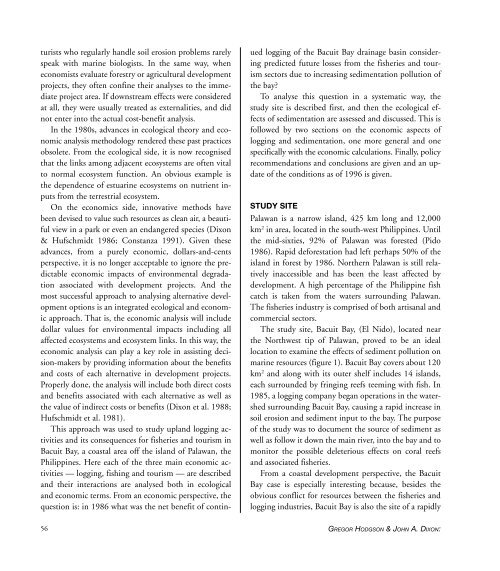You also want an ePaper? Increase the reach of your titles
YUMPU automatically turns print PDFs into web optimized ePapers that Google loves.
turists who regularly handle soil erosion problems rarely<br />
speak with marine biologists. In the same way, when<br />
economists evaluate forestry or agricultural development<br />
projects, they <strong>of</strong>ten confine their analyses to the immediate<br />
project area. If downstream effects were considered<br />
at all, they were usually treated as externalities, and did<br />
not enter into the actual cost-benefit analysis.<br />
In the 1980s, advances in ecological theory and economic<br />
analysis methodology rendered these past practices<br />
obsolete. From the ecological side, it is now recognised<br />
that the links among adjacent ecosystems are <strong>of</strong>ten vital<br />
to normal ecosystem function. An obvious example is<br />
the dependence <strong>of</strong> estuarine ecosystems on nutrient inputs<br />
from the terrestrial ecosystem.<br />
On the economics side, innovative methods have<br />
been devised to value such resources as clean air, a beautiful<br />
view in a park or even an endangered species (Dixon<br />
& Hufschmidt 1986; Constanza 1991). Given these<br />
advances, from a purely economic, dollars-and-cents<br />
perspective, it is no longer acceptable to ignore the predictable<br />
economic impacts <strong>of</strong> environmental degradation<br />
associated with development projects. And the<br />
most successful approach to analysing alternative development<br />
options is an integrated ecological and economic<br />
approach. That is, the economic analysis will include<br />
dollar values for environmental impacts including all<br />
affected ecosystems and ecosystem links. In this way, the<br />
economic analysis can play a key role in assisting decision-makers<br />
by providing information about the benefits<br />
and costs <strong>of</strong> each alternative in development projects.<br />
Properly done, the analysis will include both direct costs<br />
and benefits associated with each alternative as well as<br />
the value <strong>of</strong> indirect costs or benefits (Dixon et al. 1988;<br />
Hufschmidt et al. 1981).<br />
This approach was used to study upland logging activities<br />
and its consequences for fisheries and tourism in<br />
Bacuit Bay, a coastal area <strong>of</strong>f the island <strong>of</strong> Palawan, the<br />
Philippines. Here each <strong>of</strong> the three main economic activities<br />
— logging, fishing and tourism — are described<br />
and their interactions are analysed both in ecological<br />
and economic terms. From an economic perspective, the<br />
question is: in 1986 what was the net benefit <strong>of</strong> continued<br />
logging <strong>of</strong> the Bacuit Bay drainage basin considering<br />
predicted future losses from the fisheries and tourism<br />
sectors due to increasing sedimentation pollution <strong>of</strong><br />
the bay<br />
To analyse this question in a systematic way, the<br />
study site is described first, and then the ecological effects<br />
<strong>of</strong> sedimentation are assessed and discussed. This is<br />
followed by two sections on the economic aspects <strong>of</strong><br />
logging and sedimentation, one more general and one<br />
specifically with the economic calculations. Finally, policy<br />
recommendations and conclusions are given and an update<br />
<strong>of</strong> the conditions as <strong>of</strong> 1996 is given.<br />
STUDY SITE<br />
Palawan is a narrow island, 425 km long and 12,000<br />
km 2 in area, located in the south-west Philippines. Until<br />
the mid-sixties, 92% <strong>of</strong> Palawan was forested (Pido<br />
1986). Rapid deforestation had left perhaps 50% <strong>of</strong> the<br />
island in forest by 1986. Northern Palawan is still relatively<br />
inaccessible and has been the least affected by<br />
development. A high percentage <strong>of</strong> the Philippine fish<br />
catch is taken from the waters surrounding Palawan.<br />
The fisheries industry is comprised <strong>of</strong> both artisanal and<br />
commercial sectors.<br />
The study site, Bacuit Bay, (El Nido), located near<br />
the Northwest tip <strong>of</strong> Palawan, proved to be an ideal<br />
location to examine the effects <strong>of</strong> sediment pollution on<br />
marine resources (figure 1). Bacuit Bay covers about 120<br />
km 2 and along with its outer shelf includes 14 islands,<br />
each surrounded by fringing reefs teeming with fish. In<br />
1985, a logging company began operations in the watershed<br />
surrounding Bacuit Bay, causing a rapid increase in<br />
soil erosion and sediment input to the bay. The purpose<br />
<strong>of</strong> the study was to document the source <strong>of</strong> sediment as<br />
well as follow it down the main river, into the bay and to<br />
monitor the possible deleterious effects on coral reefs<br />
and associated fisheries.<br />
From a coastal development perspective, the Bacuit<br />
Bay case is especially interesting because, besides the<br />
obvious conflict for resources between the fisheries and<br />
logging industries, Bacuit Bay is also the site <strong>of</strong> a rapidly<br />
56 GREGOR HODGSON & JOHN A. DIXON:


















